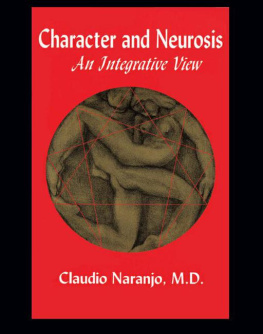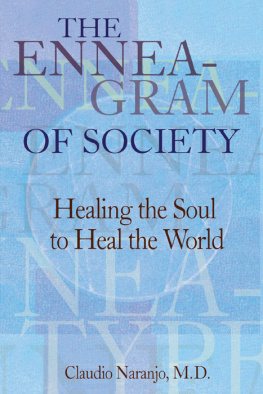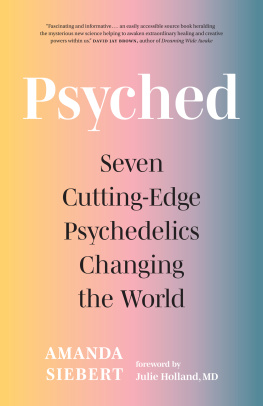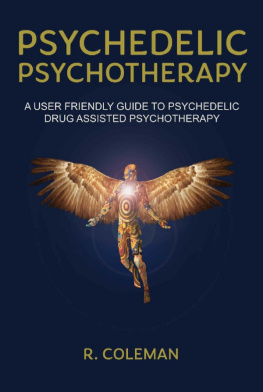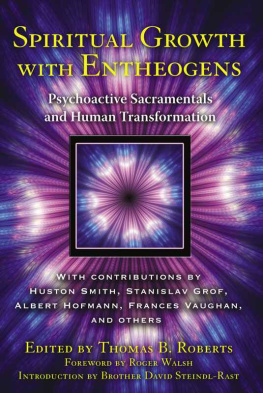my psychedelic
explorations
A remarkable collection of Claudio Naranjos writings on psychedelics and their role in spirituality and psychotherapywhat he considers two sides of the same coin. Of special value are his plentiful case reports in which we see on display the humanity and wisdom of this wise and humane psychedelic guide and trainer. Naranjos unwavering commitment to the centrality of actual experience to personal growth provides a unique perspective on understanding and utilizing the psychedelic drug state. A timely and most valuable contribution to the field.
RICK STRASSMAN, M.D., AUTHOR OF DMT: THE SPIRIT MOLECULE
Todays psychedelic culture is a hotchpotch of conflicting and harmonious factors bubbling together in a multicolored cauldron of potential. With such a long history of seemingly miraculous successes and well-known epic controversies, it takes a scholar of epic proportions to guide us through the maelstrom. Claudios yearsdecades in factof frontline immersion in the multidisciplinary field of psychedelics has now produced the go-to text to navigate this fascinating space. This book is a cutting-edge examination of contemporary science with an essential focus on the story of humanitys oldest philosophy. What better captain to steer us than the man who has been there since the beginning, always alert and vigilant to the emerging psychedelic tides and their place in our lives. Read this book; carry it with you on your journey. There can be no better map.
BEN SESSA, M.D., MRCPSYCH, PSYCHIATRIST, RESEARCHER, COFOUNDER AND COCHAIR OF BREAKING CONVENTION, AND AUTHOR OF THE PSYCHEDELIC RENAISSANCE
Imagine a life that brings together the shamanic and the scientific sides of the psychedelic renaissance, the spiritual and the therapeutic, North and South, East and West. Imagine a writer who describes, with clarity and grace, the ineffable nature of the altered state. Imagine a psychedelic pioneer who is not afraid to call out the hedonism, grandiosity, and foolishness that sometimes darken this enlightened community. Imagine Claudio Naranjo.
DON LATTIN, AUTHOR OF THE HARVARD PSYCHEDELIC CLUB AND CHANGING OUR MINDS
I first met Dr. Claudio Naranjo 50 years ago when we both studied at the Esalen Institute with Dr. Fritz Perls, the founder of Gestalt Therapy. Claudio was already a psychotherapy pioneer at that time. He has continued to lead us toward new and important information on healing, now including this magnum opus that contributes significantly to the present worldwide renaissance in psychedelic psychotherapy.
DR. RICHARD LOUIS MILLER, PH.D., AUTHOR OF PSYCHEDELIC MEDICINE
Claudio Naranjo is the most shaman of the scholars and the most learned of the shamans.
LUIS WEINSTEIN, PHOTOJOURNALIST, AUTHOR, AND FORMER PRESIDENT OF THE AMERICAN FILM INSTITUTE
Dr. Claudio Naranjo, pioneer of consciousness, has written the fundamental work for the psychotherapist who wants to not only experience but understand the world of known meditation techniques.
RABBI ZALMAN SCHACHTER-SHALOMI REB ZALMAN, ONE OF THE FOUNDERS OF THE JEWISH RENEWAL MOVEMENT
I knew Claudio for many years. He is someone who immersed himself in a great variety of teachings and practices in order to help others heal their pain and find the way to the development of consciousness.
TARTHANG TULKU RINPOCHE, TIBETAN TEACHER
Contents
Foreword
By Jose Maria Fbregas, M.D.
Philosopher, psychiatrist, teacher of therapists, seeker and finder of deep meanings of life, gestalt world reference, integrator of the psychospiritual legacy of East and West, militant and inspirer of transformative education, teacher of the healing of love as a tool for personal, social, and transpersonal change... Dr. Claudio Naranjos facets are as numerous as the thousand faces of the hero that Joseph Campbell spoke to us of (who, by the way, was his friend: one of the many remarkably interesting friends of this remarkably interesting man). However, I shall never tire of insisting on one of the lesser-known facets of this exceptional researcher with his long white beard, tender heart, and strong character: that of pioneer in psychopharmacology research from the early sixties, as well as a figure of fundamental importance in the development of psychedelic therapies, not only in the golden era of the Revolution of Consciousness in the prodigious decade, but also later, in the troubled seventies of prohibition, in the dismal eighties of the war on drugs, in the bleak nineties of conformism... and in the resurgence, forty years later, already in the twenty-first century, of the medical and humanistic interest in psychotropic substances as bearers of a new revolution, this time of psychiatry (that, unlike other fields of medicine, came to a standstill forty years ago in Haloperidol and Prozac), as well in the search for consciousness.
Let us see to what extent Claudios work has been that of a pioneer. In the midsixties, when he had already visited the Amazon to experiment firsthand with ayahuasca and already had extensive experience as a therapist, Claudio joined forces with Alexander Shulgin and Tony Sargent to research and develop a whole panoply of previously unimaginable psychotropics. It was an association of ten years with astounding results. Together, they developed over one hundred psychoactive substances. Not only that, they also rediscovered MDMA, or ecstasy, overlooked by the Merck laboratories after discovering it in 1912, believing it to be an unusable substance.
The merit of these cheerful lads of psychedelic chemistry is vast. Nowadays, researching visionary substances, psychedelics, or psychodysleptics requires great courage, but if we take this to the era when Shulgin, Naranjo, and Sargent started, we find something of great merit, at a time when there was no demand for it, neither was there a generalized sensitization about the need to open the doors of the mind to the unknown. That in the early sixties somebody should intuit and suggest the possibility of using new psychedelic substances, beyond LSD, for therapeutic uses, is most surprising. The catalog of what was created was gathered partly by Shulgin, the eldest of the three and head of the team, in his books PiKHAL ( Phenethylamines I Have Known and Loved ) and TiKHAL ( Tryptamines I Have Known and Loved ). The catalog includes substances such as TMA, DMMDA, TeMA, DOM, 2C-B, 2C-T-7, U4E... among dozens of others.
Although among the psychedelic community of the United States there has been a tendency to not sufficiently remember or value Claudios role, the invaluable results of his collaboration with Shulgin during the sixties remain, nevertheless, strongly rooted among us, and I believe that the fact that Shulgin ended up being recognized as the father of ecstasy, implies some kind of injustice in the face of team research work where Naranjo was also instrumental because of his clinical trials, both regarding MDMA and the case of so many phenethylamines.
Since we are discussing clinical trials, one of the most striking features of that team is that not only did it carry out research, but it was also first in testing the results, above all as a way of protecting future users, which I find to be of astonishing ethical nobility. Many scientists experiment on animals, but one who experiments on himself, and who is able to take on that risk and that responsibility, and share that personal experience with the public in order that it can rely on trustworthy information and previous trials, inevitably becomes a key reference for the creation and right guidance of a critical mass of conscious psychedelic warriors capable of helping many other people in their quest. For my part, I must admit that I would not be capable of lending myself as a human guinea pig to my own experiments. I do not know whether these pioneers were sure about which substances could fry their brains and which could not. Either way, they did it and they survived it.


